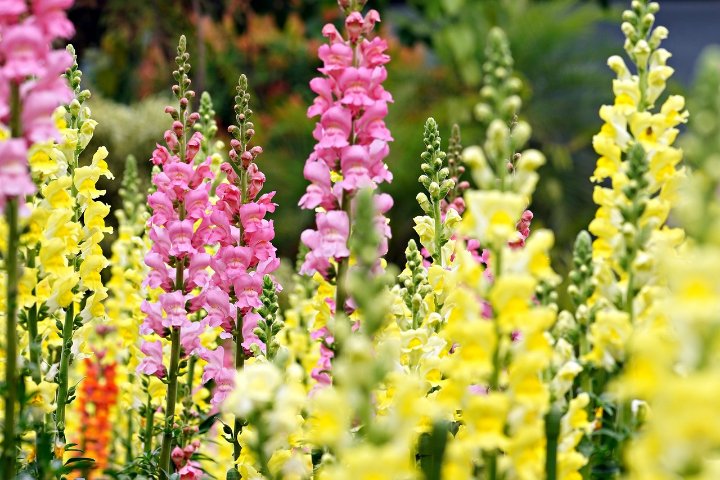Snapdragons, with their vibrant, vertical blooms, add a delightful burst of color to any garden or landscape. These versatile plants are cherished for their unique flower spikes and attractive foliage, making them a popular choice among gardeners. Whether you’re a seasoned gardener or a beginner, learning how to grow and care for snapdragons is relatively simple .
Best Snapdragon Varieties
| Image | Name | Rating | Shop |
|---|---|---|---|
 | Snapdragon Seed Mix |  | |
 | Liberty Classic Mix Snapdragon Seeds |  | |
 | Snapdragon- Apple Blossom |  | |
 | Hot Pink Snapdragon Seeds |  |
Snapdragon Hardiness Zones
Snapdragons are classified as perennial plants in USDA hardiness zones 7 to 11. However, they are often grown as annuals in cooler climates due to their sensitivity to frost. In warmer regions, snapdragons can thrive year-round, providing continuous blooms and vibrant colors to the garden.
How Much Sun Do Snapdragons Need
Snapdragons thrive in a sunny environment but can tolerate partial shade, particularly in regions with intense summer heat. Ideally, plant them in a location that receives at least six hours of direct sunlight daily. Adequate sun exposure ensures sturdy growth and abundant flowering, resulting in a more vibrant and healthy display of blooms.
Snapdragon Soil Requirements
When it comes to soil, snapdragons prefer moist, well-draining conditions. They thrive in loamy, fertile soil that retains moisture without becoming waterlogged. Prior to planting, amend the soil with organic matter such as compost or aged manure to improve its texture and fertility. Additionally, ensure proper drainage to prevent waterlogging, which can lead to root rot and other issues.
Snapdragon Soil pH
Snapdragons prefer slightly acidic to neutral soil with a pH range between 6.0 and 7.0. Test the soil pH before planting and make necessary adjustments using organic amendments or pH-adjusting products if needed. Maintaining the proper soil pH ensures optimal nutrient uptake and healthy growth for your snapdragons.
Snapdragon Plant Spacing
When planting snapdragons, space them approximately 6 to 48 inches apart, depending on the variety’s mature size. Taller cultivars may require more space to accommodate their height and sprawling growth habit, while dwarf varieties can be planted closer together. Adequate spacing allows for proper air circulation and reduces the risk of disease.
Snapdragon Water Requirements
Snapdragons require regular watering to keep the soil consistently moist but not waterlogged. Provide approximately 1 inch of water per week, adjusting as needed based on rainfall and temperature conditions. During hot, dry periods, monitor soil moisture levels closely and water more frequently to prevent drought stress. Avoid overhead watering to minimize the risk of foliar diseases.
Snapdragon Temperature Requirements
Snapdragons thrive in cooler temperatures and may struggle in regions with intense summer heat. Plant them in early spring or late summer to take advantage of milder weather conditions. In warmer climates, provide afternoon shade or mulch around the base of the plants to keep the soil cool and retain moisture.
Snapdragon Humidity Requirements
Snapdragons prefer low humidity environments and may suffer in areas with high humidity levels. Adequate air circulation and spacing between plants can help mitigate humidity-related issues such as fungal diseases. If growing snapdragons in humid climates, choose disease-resistant varieties and avoid overhead watering to minimize moisture on the foliage.
Snapdragon Fertilizer Requirements
Snapdragons are relatively light feeders but benefit from occasional fertilization to promote healthy growth and abundant flowering. Apply a balanced, slow-release fertilizer with a ratio of 10-10-10 in early spring, following package instructions for application rates. Avoid over-fertilizing, as excessive nitrogen can lead to lush foliage at the expense of flowers.
Snapdragon Pests
Snapdragons are susceptible to common garden pests such as aphids and spider mites, particularly during periods of warm, dry weather. Monitor plants regularly for signs of pest infestation and treat affected areas promptly with insecticidal soap or neem oil to control the pests. Additionally, encourage natural predators such as ladybugs and lacewings to help keep pest populations in check.
Snapdragon Diseases
Snapdragons may be prone to fungal diseases such as rust fungus and leaf spot, especially in humid or poorly ventilated conditions. To prevent disease issues, provide adequate air circulation by spacing plants properly and avoiding overcrowding. Remove and destroy any diseased foliage promptly, and apply fungicidal treatments as needed to protect your snapdragons from further infection.
With proper care and attention to their growing requirements, snapdragons can thrive in gardens, containers, and flower beds, providing a stunning display of colorful blooms throughout the growing season. Whether used as bedding plants, border accents, or cut flowers for arrangements, snapdragons are sure to bring joy and beauty to any garden space.
















